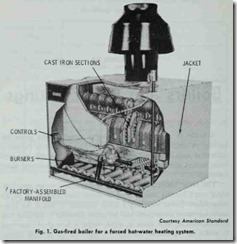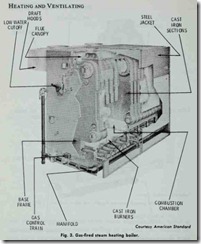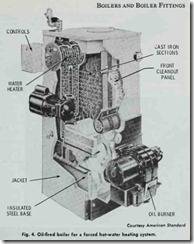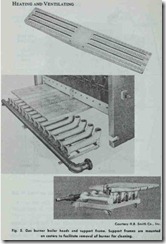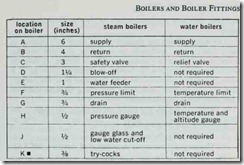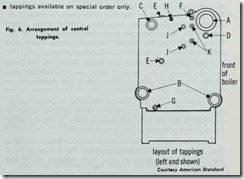Boilers and Boiler Fittings
A boiler is a device used to supply steam or hot water for heating, processing or power purposes. This chapter is primarily concerned with a description of the low-pressure steam and hot water boilers used in the heating systems of residences and small buildings.
The basic construction of both low-pressure steam and hot water space heating boilers fired by fossil fuels consists of an in sulated steel jacket enclosing a lower chamber in which the com bustion process takes place and an upper chamber containing cast iron sections or steel tubes in which water is heated or converted to steam for circulation through the pipes of the heating system (Figs. 1, 2, 3, and 4).
The design and construction of the lower chamber will de pend upon the type of fuel used to fire the boiler. It serves as a combustion chamber for coal- and oil-fired boilers, and as a com partment for housing the gas burner assembly on gas-fired boilers. These gas burner assemblies are generally designed for easy re moval so that they can be periodically ck!aned or serviced (Fig. 5).
Oil burners are externally mounted with the burner nozzle extending into the combustion chamber. This is also true of gas conversion burners. Gas burner assemblies, on the other hand, are located inside the lower chamber of the boiler.
The cast iron sections or steel tubes in the upper chamber of the boiler contain water which circulates through the pipes in the heating system either in the form of steam or hot water. The heat from the combustion process in the lower chamber of the boiler is transferred through the metal surface of the cast iron sections or steel tubes to the water contained in them, causing a rise in tem perature. The amount of water contained in these passages is one of the ways in which steam and hot water space heating boilers are distinguished from one another. In hot water space heating boilers, these passages are completely filled with water; whereas in low-pressure steam boilers only the lower two thirds is filled. In the latter, the water is heated very rapidly causing steam to form in the upper one third. The steam, under pressure, rises through the supply pipes connected to the top section of the boiler.
A boiler jacket contains a number of different openings for pipe connections and the mounting of accessories. The number and type of openings on a specific boiler jacket will depend upon the type of boiler (e.g. steam or hot water). Among the different types of openings to be found on a boiler jacket are the flue con nection, water feed (supply) connection, inspection and cleanout tapping, blow down tapping, relief valve tapping, control tapping, drain tapping, expansion tank tapping and return tapping. There are also gas and oil burner connections. Fig. 6 illustrates the ar rangement of control tappings for American Standard gas-fired steam and hot-water boilers.
Most (but not all) of the controls on low-pressure steam and hot-water space heating boilers fired by the same fuel are similar in design and function; however, there are exceptions. For ex ample, a few boiler controls and fittings are designed to be spe cifically used on steam boilers; whereas others are found only on hot-water space heating boilers. The various types of boiler controis and fittings are described in the appropriate sections of this chapter.
BOILER RATING METHODS
The construction of low-pressure steel and cast-iron heating boilers is governed by the requirements of the ASME Boiler and Pressure Vessel Code. This is a nationally recognized code used by boiler manufacturers, and any boiler used in a heating installa tion should clearly display the ASME stamp. State and local codes are usually patterned after the ASME Code.
The location of the identification symbols used by the ASME is specified by the code and determined by the type of boiler. For tappings available on special order only.
example, on a water-tube boiler, it appears on a head of the steam outlet drum near and above the manhole opening. On ver,tical fire-tube boilers, the stamp bearing the identification symbol should appear on the shell above the fire door and handhole opening. Other types of boilers (e.g. scotch marine, superheaters,etc.) have their own specified location for the identification symbol stamp.
The ASME Boiler and Pressure Vessel Code only applies to boiler construction, specifically to maximum allowable working pressures, and not to its heating capacity. A number of different methods are used to rate the heating or operating capacity of a boiler. The boiler manufacturers have developed their own ratings, but these are generally used along with rating methods available from the following organizations:
1. Institute of Boiler and Radiator Manufacturers (IBR).
2. Steel Boiler Institute (SBI).
3. American Gas Association (AGA).
4. Mechanical Contractors Association of America (MCAA).
The Institute of Boiler and Radiator Manufacturers has adopted a code for rating most types of sectional cast-iron boilers. Steel boilers are rated by the Steel Boiler Institute rating code. The Mechanical Contractors Association of America has devised a method for rating boilers not covered by either the SBI or IBR Codes. Finally, gas-fired boilers are rated in accordance with methods developed by the American Gas Association.
Other organizations which rate boilers include the Packaged Fire-tube Branch of the American Boiler and Affiliated Industries (ratings for modified scotch marine boilers) and numerous inter national groups.
In terms of its heating capacity, the rating of a boiler can be expressed in square feet of equivalent direct radiation (EDR) or thousands of Btu per hour. Sometimes a boiler horsepower rating is also given, but this has proven to be misleading.
For steam boilers, 1 square foot of direct radiation (EDR) is equal to the emission of 240 Btu per hour. For a water boiler, 1 square foot EDR is considered equal to the emission of 150 Btu per hour.
A boiler horsepower (BHP) is the evaporation of 34.5 pounds of water into dry steam from and at 212°F. For rating purposes, 1 BHP is considered as the heat equivalent of 140 square feet of steam radiation per hour. BHP ratings are in some cases obtained by dividing steam SBI Ratings by 140.
A boiler is rated according to its operating or heating capacity, but this rating will vary in accordance with the type of load used as the basis for the rating. The three types of connected loads used to determine the rating of a boiler are:
1. Net load,
2. Design load,
3. Gross load.
Net load refers to the actual connected load of the heat emit ting units in the steam or hot-water heating system. Design load includes the net load rating plus an allowance for piping heat loss. Finally, gross load will equal the net load and the piping heat loss, plus an additional allowance for the pickup load.
